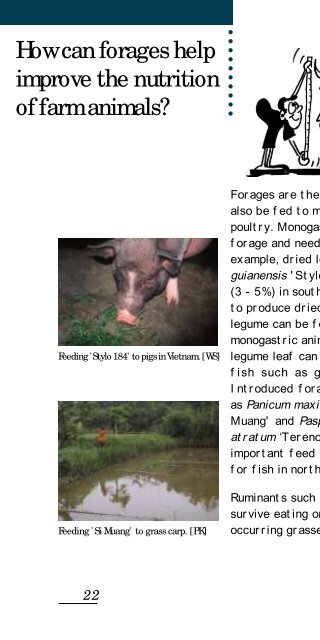Planting from vegetative material - cgiar
Planting from vegetative material - cgiar
Planting from vegetative material - cgiar
You also want an ePaper? Increase the reach of your titles
YUMPU automatically turns print PDFs into web optimized ePapers that Google loves.
How can forages help<br />
improve the nutrition<br />
of farm animals?<br />
Feeding 'Stylo 184' to pigs in Vietnam. [WS]<br />
Feeding 'Si Muang' to grass carp. [PK]<br />
22<br />
○ ○ ○ ○ ○ ○ ○ ○ ○ ○<br />
Forages are the primary feed of ruminants but they can<br />
also be fed to monogastric animals such as pigs and<br />
poultry. Monogastric animals can only eat small amounts of<br />
forage and need other high-energy feeds to grow well. For<br />
example, dried legume leaf meal made <strong>from</strong> Stylosanthes<br />
guianensis 'Stylo 184' is used in feed rations for chickens<br />
(3 - 5%) in southern China. Another legume commonly used<br />
to produce dried leaf meal is Leucaena leucocephala. Fresh<br />
legume can be fed to chickens, ducks, pigs and other<br />
monogastric animals in small quantities. Fresh grass and<br />
legume leaf can be fed to plant-eating<br />
fish such as grass carp.<br />
Introduced forages such<br />
as Panicum maximum 'Si<br />
Muang' and Paspalum<br />
atratum ‘Terenos’ are<br />
important feed sources<br />
for fish in northern Vietnam.<br />
Ruminants such as cattle, buffalo, sheep and goats can<br />
survive eating only low-quality feeds such as naturally<br />
occurring grasses, crop residues and tree leaves.
















